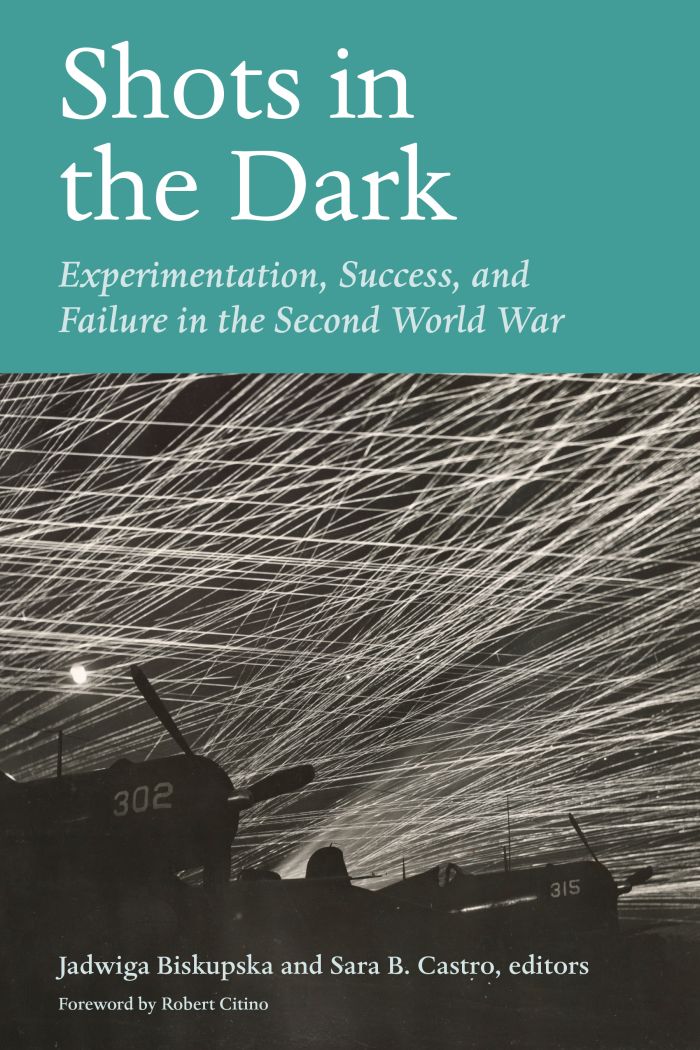Save 25% plus free shipping during our Winter Sale! Use promo code JOY2025. Expires 1/5/26.
Shots in the Dark
Experimentation, Success, and Failure in the Second World War

This book can be opened with

Brings together geographies and methodologies often kept apart by the difficulties of researching such a broad-ranging topic as the war
Shots in the Dark offers cutting-edge scholarship across different subfields in World War II history, revealing new insights into how this crucial conflict was planned, experienced, and fought. Twelve chapters demonstrate the broad scope of wartime innovation and how the war functioned as a global turning point, driving change at all levels of human society, from government institutions to individual identities.
Contributors collaborated in a vibrant workshops series sponsored by the North American branch of the Second World War Research Group (SWWRGNA), an organization that emerged to nurture scholarship on the global war and unite scholars fragmented in narrower regional and methodological “stovepipes” to consider the war as a whole. The SWWRGNA and this volume showcase the work of diverse historians across subfields—operational, cultural, gender, social, intelligence, and diplomatic history. This approach exposes the Second World War as a catalyst for overlapping global changes that revolutionized the world after 1945. These scholars reveal continuities and parallels in wartime experiences that would remain invisible in narrowly focused projects.
The volume establishes three frameworks for understanding and interpreting changes the war provoked: 1) institutional adaptation, 2) “totalization,” or the militarization of civilians, and 3) cultural transformation. Each of the three frameworks is explored from four vantage points. Geographies are deliberately contrasted within each framework to examine the broad scope of that level of war-driven change.
The editors are to be congratulated for producing an excellent book which sets wide-ranging and ambitious intellectual goals and assuredly fulfills them. It will be of great value and interest to scholars of the Second World War and Twentieth Century global history.—Andrew Stewart, Visiting Professor, King’s College London
Jadwiga Biskupska is an associate professor of military history at Sam Houston State University and co-director of the Second World War Research Group, North America. She completed her PhD at Yale University and is the author of Survivors: Warsaw under Nazi Occupation (Cambridge, 2022), which won the 2022 Heldt Prize of the Association for Women in Slavic Studies.
Sara B. Castro (Edited By)
Sara B. Castro is an associate professor of history at the US Air Force Academy in Colorado Springs, Colorado, where she teaches global, military, and East Asian history. She served as president of the Society of Intelligence Historians (SIH), 2022–2024. She completed her PhD at the University of North Carolina, Chapel Hill and is the author of Mission to Mao: US Intelligence and the Chinese Communists in World War II (Georgetown, 2024).
Foreword
Robert Citino | ix
Introduction: Taking Our First Shots in the Dark
Jadwiga Biskupska | 1
Part I Institutional Adaptation
1. The Dixie Mission(aries): The Protestant Roots of US Intelligence Officers in Wartime China
Sara B. Castro | 13
2. The Diversity and Versatility of British Intelligence in Iraq, 1939-1945
Adrian O'Sullivan | 35
3. Prelude to Barbarossa? The 4th Mountain Division War in Yugoslavia, April-May 1941
Jeff Rutherford | 61
4. "Believed Reliable": The "Morale and Opinions" of German Prisoners of War in the United States,
February 1944-June 1945
Derek R. Mallett | 85
Part II Totalization: The Militarization of Civilians
5. Montelimar's Phony War: Requisitions, Mobilization, and French Civilians
Cameron Zinsou | 113
6. Red Army Divisions' Growing Demand for Artistic Service: Entertainment at the Front, 1941-1945
Erina Megowan | 134
7. From Covert Reports to Front-Page News: How North American Newspaper Reports Contributed to Views on Reconnaissance Actions in Northwest Europe
Victoria Sotvedt | 158
8. "Everything We Can Lay Hands On": Canadian Soldiers and Sexual Violence in Germany in 1945
Claire Cookson-Hills | 179
Part III Cultural Transformation
9. "The Men of Bataan Lived Up to the Best American Tradition":
Journalists, Civilians, Politicians, and the Meaning of Surrender during World War II
Elena M. Friot | 207
10. Who Do You Believe? Loyalty and Asian Americans in the OSS during World War II
Brian Masaru Hayashi | 230
11. World War II and Soviet Intelligence and State Security Officer Defectors
Kevin P. Riehle | 250
12. The Space Between: Hildegard Beetz, Espionage, and Gender, 1944-1949
Katrin Paehler | 278
Acknowledgments | 305
Acronyms and Abbreviations | 307
Contributors | 311
Index | 315




